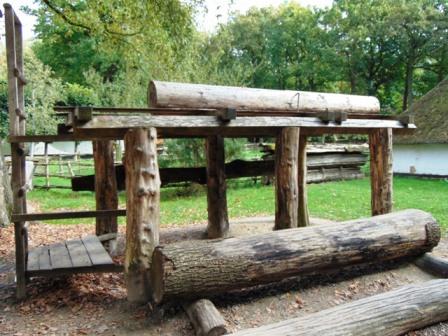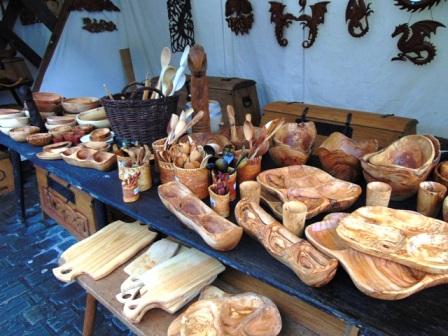Wood consists mainly of the cell wall components cellulose and hemicelluloses, which are held together by lignin. The cambium layer under the bark makes new cells (wood) and thus forms rings by seasonality. The wood inside the cambium is already dead.
 Wood shrinks as it dries and swells when it gets wet. It deforms rather by moisture than temperature, every season and every day. For structures with other materials you should properly take this into account.
Wood shrinks as it dries and swells when it gets wet. It deforms rather by moisture than temperature, every season and every day. For structures with other materials you should properly take this into account.
Cracks are formed traverse through the rings to the heart of the wood.
Recognizing trees (in all seasons) and woods takes practice and experience.
A plank sawn according the radius of the wood (from the mid of the clock to a quarter) is quarter sawn. Plain is like a circle chord cut.
To cut a trunk in planks in our region was used a saw pit, sometimes a rack. One man beneth, and one on top to operate a big whipsaw. The Chinese had a simpler trick: a significant rack in the shape of an A. The stem was pushed trough the upper portion, and formed with the two feet a stable structure.
 Reaction wood is formed in response to a non- steady state of (impending) tilt (by subsidence, searching light, wind load, (fungus) attack). Reaction wood occurs on one side of a tree as resistance to bending. To restore the balance deciduous trees form tension wood and pine compression wood, in the places where stresses occurs. Tension wood is located at the top of the trunk and pulls the stem in the right direction, compression wood is located at the bottom (lower side), and pushes the trunk to stable state. In the reaction timber, both the anatomical structure of the cell structures, as the chemical composition are different. There is an increased proportion of lignin and other extract compounds. Auxin is a growth hormone. It is produced in the leaves and transported downward. It stays in tension zones and there stimulates the growth of timber.
Reaction wood is formed in response to a non- steady state of (impending) tilt (by subsidence, searching light, wind load, (fungus) attack). Reaction wood occurs on one side of a tree as resistance to bending. To restore the balance deciduous trees form tension wood and pine compression wood, in the places where stresses occurs. Tension wood is located at the top of the trunk and pulls the stem in the right direction, compression wood is located at the bottom (lower side), and pushes the trunk to stable state. In the reaction timber, both the anatomical structure of the cell structures, as the chemical composition are different. There is an increased proportion of lignin and other extract compounds. Auxin is a growth hormone. It is produced in the leaves and transported downward. It stays in tension zones and there stimulates the growth of timber.
On the side where reaction wood is formed mostly wide growth rings can be seen with an abnormally large amount of late wood where the rings are widest. The tree often has a slightly oval shape rather than round.
Compression wood is also present at the bottom of branches. It usually has thick-walled cells and is often dark brown (sometimes called ‘red wood’). It is much harder than normal wood of the same species, but usually has lower strength properties. When drying it usually causes a large and irregular length contraction which pulls the warp (to cup, kink, bow, crook, twist).
Tension wood is also situated on the top of branches. Again, the growth rings generally are wider, thicker, and the structure of the cell walls thicker and harder than ordinary wood.
Typically, it is less noticeable than compression timber, but has the same shrinkage properties.
Because reaction timber is created to compensate for tension, when sawing an enormous tension is set free. Shrinking, twisting or warping are much larger.
At the solar eclipse on 11 August 1999, plant sensors registered in Belgium for the first time in history how the wood reacts to the sudden lack of light: the sap flow stops.
Sensors measure that the stem captures and compensates the imbalance in water demand and supply by tiny fluctuations of swelling and shrinking in a fixed daily pattern.
The leaves start to perspire on the first sunlight. The stem responds like an elastic tube on this imbalance and is shrinking. Water is sucked up by the roots. That will continue, as the leaves at sunset close their stomata.
Stère
A stere is a volume of one cubic meter (m³) stacked firewood. Depending on shape (cleft, crooked..), bark thickness, type of wood that is on average 0.66 m³ (1.50 stere is about 1 m³).
Oak, beech, ash weigh about 490 kg per stere. Air dry hardwood weighs an average of 400 kg, 300 kg for 1 stere softwood. The corresponding heating value of 1 stere air dry wood for hardwood: 400kg x 15,2 MJ / kg = 6,08 GJ. For softwood: 300kg x 16,8 MJ = 5,04 GJ.
The heat of combustion (on a scale of 0-10, 10 corresponds to 9,2 GJ / m³), is broadly consistent with the hardness, which is highly dependent on the density, and runs in parallel with the price.
Wood is a natural material and uneven, the properties are therefore also variable and dependent on location of growth, structure...
To burn wood properly, the combustion chamber should have a temperature of 400 to 500°C.
|
Alder 7,1 |
Beech 8,5 |
Chestnut 9,2 |
|
|
Poplar 5,3 |
Birch 7,9 |
Fruit 8,6 |
Oak 9,2 |
|
Willow 5,8 |
Elm 8,3 |
Maple 8,8 |
Acacia 9,8 |
|
Linde 6,4 |
Nuts 8,5 |
Ash 9,1 |
Hornbeam 10 |
Softwood is (only) useful as kindling. It is notorious for polluting flues and splash and sparks when lit.
|
Pine 5,7 - 6,1 |
Larch (larch) 8,4 |
Spruce, fir 9,6 |
